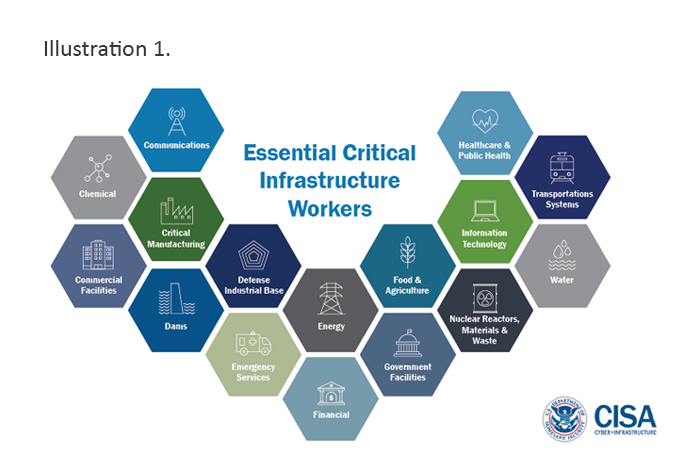An official website of the United States government
 United States Department of Labor
United States Department of Labor
| September 2020
During a crisis, like a hurricane or the COVID-19 pandemic, some organizations close temporarily while others continue—perhaps even changing their mission. Which workers stay on the job in chaotic times, and what’s the long-term outlook in their occupations?
Workers in hospitals, food manufacturing plants, and utilities are among those who may be required to report in person. Exactly which workers are considered “essential” may differ, depending on where they live and other factors. But the goods or services that they provide are nearly always vital, in some way, to life and welfare.
This article highlights U.S. Bureau of Labor Statistics (BLS) data for selected occupations in which workers help to carry out critical tasks. Keep reading to learn more about the employment, projected openings, wages, and typical entry requirements for these occupations.
What’s considered essential work in emergencies may vary, depending on where you live. Guidelines from the U.S. Department of Homeland Security (DHS) suggest that the essential workforce includes those who provide:
The occupations selected for this article are just a few of the hundreds of occupations that the Labor Market Information (LMI) Institute identifies as being part of the critical infrastructure workforce, as outlined by the DHS Cybersecurity and Infrastructure Security Agency (CISA). (See illustration 1.)

Workers in essential occupations have a variety of duties. Not all workers in these occupations are called on during a crisis, but some are. And they often must risk their own health or safety in such circumstances.
For selected occupations, tables in each section that follows show 2019 employment, 2019 median annual wages, and the entry-level education and training typically required. (Compare wages in these occupations with $39,810, the median annual wage for all occupations in 2019.)
The tables also show the number of occupational openings BLS projects each year, on average, from 2019 to 2029. BLS projections focus on long-term trends that capture structural change in the economy, such as growth in online sales or increased demand for healthcare. The projections do not consider events that impact short-term conditions, such as a stock-market surge or natural disaster. (Any long-term economic changes that may result from the COVID-19 pandemic had not yet been determined at the time the 2019–29 projections were developed.)
Helping people stay or get well and keeping them safe is the job of many workers in career fields such as healthcare and protective service. Selected occupations involved in this work are shown in table 1. Physicians and surgeons includes detailed occupations such as anesthesiologists, internal medicine physicians, and pediatricians.
Janitors and cleaners is the occupation in table 1 that’s projected to have the most openings—about 305,600 each year, on average, from 2019 to 2029. With nearly 2.4 million workers in 2019, this occupation had the second-largest employment of those shown in table 1. It is surpassed in the table only by registered nurses, which had more than 3 million workers.
Median annual wages for the occupations in table 1 ranged from $27,430 for janitors and cleaners to $208,000 or more, the highest median wage published by the BLS Occupational Employment Statistics program, for physicians and surgeons. Education requirements also varied, with occupations that pay more typically requiring higher levels of education than ones paying less.
Making sure millions of people in crisis have what they need, such as food and medication, is a big undertaking. Workers in farming and fishing, production, and transportation and material moving occupations are among those who help to get essential products to consumers. Table 2 shows some of these occupations. Food processing workers includes occupations such as bakers, butchers, and others in food production. Agricultural workers includes farmworkers and laborers, agricultural equipment operators, and related occupations.
Of the occupations in table 2, cashiers is projected to have the most openings—about 562,300 each year, on average, from 2019 to 2029. Despite projected declines in employment for cashiers, which is due to the greater use of self-service checkout stands and increased online sales, BLS still expects many openings over the decade because of the need to replace workers who leave this large occupation.
Transportation, storage, and distribution managers had the highest median annual wage ($94,560) in 2019 of the occupations in table 2. Nearly all of the occupations in the table typically require a high school diploma or less education for entry.
Utilities, information technology systems, banks, and other vital infrastructure require support from a variety of workers. (See table 3.) For example, there are several types of plant and systems operators, such as those who work at chemical, power, and water treatment plants. Similarly, engineering occupations include civil, industrial, and mechanical engineers.
In table 3, the three largest occupations—general maintenance and repair workers, engineers, and electricians—together are projected to have about 339,100 openings each year, on average, from 2019 to 2029. That’s more than the projected openings of all other occupations in the table combined.
In 2019, financial managers had the highest median annual wage ($129,890) of the occupations in table 3. A bachelor’s degree plus related work experience is typically required to enter this occupation. Many of the other occupations in the table typically require a high school diploma or equivalent for entry.
Learn about the occupations in this article, and hundreds of others, in the Occupational Outlook Handbook (OOH). The OOH has information about what workers do, along with their wages, job outlook, and more.
Visit CareerOneStop for online resources to help find a job, explore careers, and locate training programs near you. Jobseekers can get free help with a variety of employment-related needs from their local American Job Center.
Elka Torpey, "Essential work: Employment and outlook in occupations that protect and provide," Career Outlook, U.S. Bureau of Labor Statistics, September 2020.